It was a very nice day today, hot and comparatively dry. The maximum temperature was 38 degrees, with a humidity of about 40 percent, and it was cloudy enough that the sun didn’t heat up my room to resemble a sauna.
I took myself as usual to my favourite place at Yoshida shrine until the late afternoon, when I could hear thunder in the distance. I then sat at my window watching the storm approaching over the city from the South where there are no mountains. It took only half an hour and lots of lightning – which unfortunately I was always just a fraction too late to capture on camera – until the rain finally arrived at Ebisu’s. And then, everything was over almost as quickly. 
Thunderstorms in this part of the world are not overly pleasant, I think. While in Austria, a summer storm is always a reason to be grateful for as it cools the area and leaves fresh air behind, this is not so in Asia, as I had to find out before. Mostly, the rain has no cooling effect whatsoever, and there is hardly any fresh air afterwards, although there may be this nice “wet” smell lingering for a short while. Thunderstorms in these parts seem only to be there to raise the humidity, so the general feeling when one has just passed is one of increased stickiness, which is not really something to look forward to.
This time, probably because the storm came so late in the afternoon, there was an unexpected and quite refreshing drop in temperature of about 5 degrees. It does feel nice and cool right now, I may even need a blanket for the first time since I returned from vacation! Unfortunately, humidity has doubled to 80 percent – and it may stay just like that tomorrow…
Isn’t it nice to be able to complain about the weather no matter what it is and where you are? 😉













